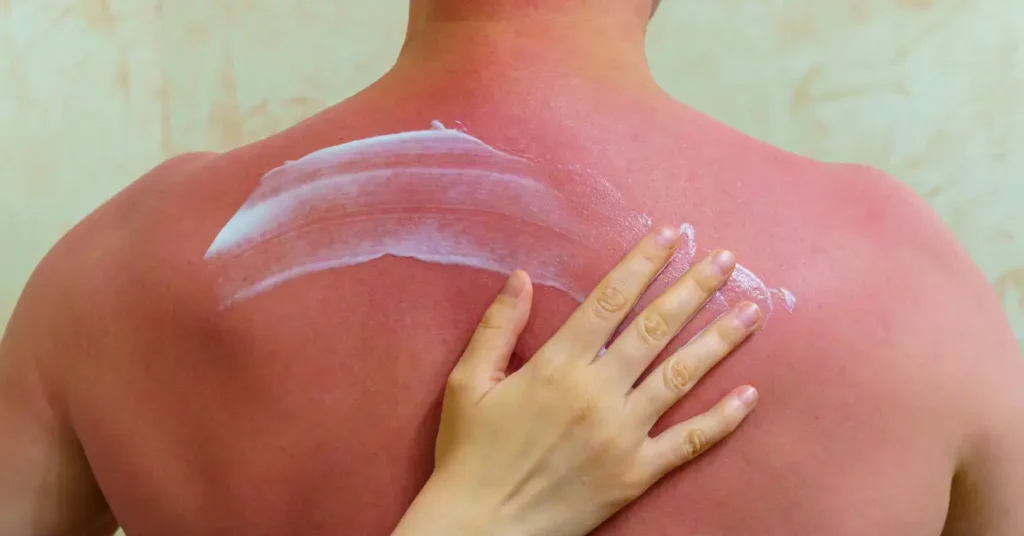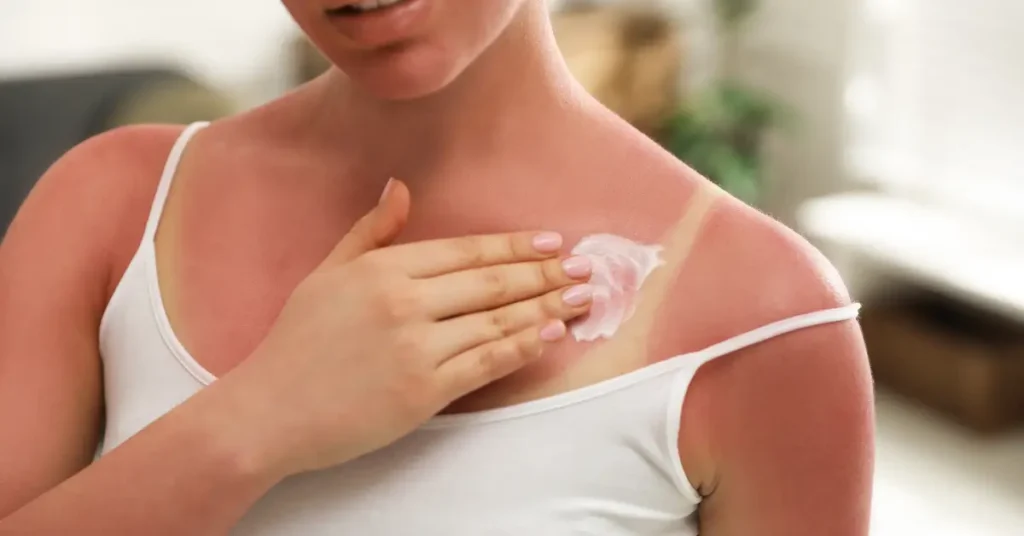Today we are talking about ‘how long does it take for a sunburn to heal’ A sunburn typically takes about 3-7 days to heal completely. Sunburns can vary in severity and healing time based on factors such as the individual’s skin type, the amount of sun exposure, and the extent of the burn.
However, proper care and treatment can speed up the healing process. Sunburn, a common skin condition caused by overexposure to the sun’s ultraviolet (UV) rays, can result in redness, pain, and peeling of the affected area. The healing process begins as soon as the skin is no longer exposed to the sun.
Initially, the affected area may feel warm and tender. Over the next few days, peeling and flaking may occur as the damaged skin begins to repair itself. While the duration of healing can vary, it is essential to take precautions to prevent further damage and promote healing. This article discusses the factors affecting sunburn healing time and offers some tips for managing sunburn symptoms. Proper care and treatment are crucial in ensuring a speedy recovery from sunburn.
how long does it take for a sunburn to heal -Understanding Sunburn Healing Time?

Sunburn healing time varies depending on the severity of the burn, but generally, it takes about 3-7 days for mild sunburns to heal completely.
Understanding Sunburn Healing Time Sunburn is a common skin condition that occurs when the skin is exposed to excessive ultraviolet (UV) radiation from the sun. It can cause redness, pain, swelling, and even blistering in severe cases. If you have ever experienced a sunburn, you may have wondered how long it takes for your skin to heal. Well, the healing time for sunburn can vary depending on various factors.
Factors Influencing Healing Rate
Several factors can influence the rate at which a sunburn heals. These factors include: 1. Sunburn severity: The severity of the sunburn plays a significant role in determining the healing time. Sunburns are often classified into three levels: mild, moderate, and severe. The more severe the sunburn, the longer it may take for your skin to heal. 2. Skin type: Different skin types have varying degrees of sensitivity to UV radiation. People with fair skin are more prone to sunburns and may take longer to heal compared to those with darker skin tones. 3. Individual’s immune system: A person’s immune system also plays a role in the healing process. A strong immune system can help speed up the healing of a sunburn, while a weakened immune system may delay the healing process. 4. Age: Young children and the elderly tend to have slower healing times compared to young adults. This is because the skin’s ability to regenerate and repair itself decreases with age. 5. Additional skin conditions: If you have underlying skin conditions such as eczema or psoriasis, your sunburn healing time may be longer. These conditions can make your skin more susceptible to damage and slow down the healing process.
The Role Of Skin Severity Levels
As mentioned earlier, sunburns can be categorized into three levels based on their severity: mild, moderate, and severe. The severity of sunburn is determined by the extent of the damage to the skin’s layers. 1. Mild sunburn: Mild sunburns are characterized by redness, tenderness, and slight swelling of the affected area. They usually heal within a few days to a week. Applying soothing lotions and cool compresses can help alleviate the discomfort. 2. Moderate sunburn: Moderate sunburns may involve more intense redness, blistering, and pain. These sunburns can take up to two weeks to heal completely. It’s essential to keep the affected area clean and moisturized to prevent infection. 3. Severe sunburn: Severe sunburns are the most damaging and can result in widespread blistering, significant pain, and even fever. Healing time for severe sunburns can range from two to three weeks. Medical attention may be necessary to manage the symptoms and prevent complications.
The healing time for a sunburn depends on various factors such as sunburn severity, skin type, immune system, age, and underlying skin conditions. Mild sunburns typically heal within a few days to a week, while moderate and severe sunburns may take up to two to three weeks. It’s crucial to protect your skin from harmful UV radiation to prevent sunburns and promote faster healing when they do occur.
how long does it take for a sunburn to heal are Managing Sunburn For Faster Healing

The healing time for sunburn varies, but with proper management, it can be accelerated. Discover effective strategies to promote faster healing and alleviate discomfort.
Managing Sunburn for Faster Healing Sunburn can be an uncomfortable and painful experience, leaving your skin red, tender, and sensitive to touch. While time is the ultimate healer, there are steps you can take to speed up the recovery process and find relief sooner. By focusing on hydration, cooling, and protecting the skin, as well as using moisturizers and aloe vera, you can help your sunburn heal more quickly. Let’s explore these strategies in more detail.
Hydration And Its Importance
One of the most important things you can do to manage and heal your sunburn is to stay hydrated. Sunburn can dehydrate your body, leading to dryness and further damage to your skin. Make sure to drink plenty of water throughout the day to replenish your fluid levels. Proper hydration can also help soothe your skin and reduce inflammation. Aim to drink at least eight glasses of water per day to support your body’s natural healing process.
Cooling And Protecting The Skin
When it comes to managing sunburn, cooling your skin is crucial. Applying a cool compress or taking a cool bath can provide immediate relief and help reduce redness and swelling. Just remember to avoid using ice directly on your skin, as it can cause further damage. Instead, wrap ice packs in a thin towel and gently apply them to the affected areas for short durations. In addition to cooling, protecting your sunburned skin from further damage is essential. Minimize your exposure to direct sunlight and seek shade whenever possible. Wearing loose-fitting, breathable clothing that covers the affected areas can offer some much-needed protection. Don’t forget to use a broad-spectrum sunscreen with a high SPF when you venture outdoors, as sunburned skin is more susceptible to the sun’s harmful UV rays.
Moisturizers And Aloe Vera Benefits
Once you’ve cooled and protected your sunburned skin, nourishing it with moisturizers and aloe vera can aid in faster healing. Moisturizers help hydrate and soothe the skin, relieving dryness and reducing peeling. Look for moisturizers that are specifically formulated for sunburned skin and contain ingredients like aloe vera, chamomile, or vitamin E. Aloe vera, in particular, is renowned for its healing properties. This natural gel has been used for centuries to treat various skin conditions, including sunburn. Applying aloe vera directly to your sunburned skin can provide instant relief by cooling the area and promoting skin regeneration. Look for pure aloe vera gel or lotions containing a high percentage of aloe vera for maximum effect. By focusing on hydration, cooling, and protecting the skin, and utilizing the benefits of moisturizers and aloe vera, you can help your sunburn heal faster. Remember to be gentle with your skin, avoid harsh chemicals or irritants, and give your body the time it needs to recover. With these strategies in your arsenal, you’ll be on your way to finding relief and enjoying healthy, sun-kissed skin once again.
how long does it take for a sunburn to heal is Preventing Sunburn Complications

When it comes to sunburn, prevention is undoubtedly the best course of action. However, if you do find yourself with a sunburn, it’s essential to take steps to prevent any potential complications. By following simple infection prevention methods and reducing the risk of scarring, you can aid the healing process and ensure a speedy recovery.
Infection Prevention Methods
As sunburn damages your skin, it becomes more susceptible to infection. To avoid any further complications, it is crucial to keep the affected area clean and free from bacteria. Here are a few infection prevention methods you can follow:
- Keep the sunburned area clean by gently washing it with mild soap and water.
- Pat the area dry with a clean towel, ensuring you do not rub it, as it can irritate the skin further.
- If any blisters appear, avoid popping or scratching them, as this can introduce bacteria and increase the risk of infection.
- Apply a topical antibiotic ointment, such as Bacitracin or Polysporin, to any cracked or open skin to prevent infection.
- Wear loose-fitting, breathable clothing to avoid further irritation and promote airflow to the affected area.
Reducing The Risk Of Scarring
While sunburns may be temporary, they can sometimes leave behind unwanted scars. To minimize the risk of scarring and promote healthier skin regeneration, consider the following:
- Avoid picking at peeling or flaking skin, as this can prolong the healing process and increase the likelihood of scarring.
- Moisturize the sunburned area with a gentle and hydrating lotion, such as one containing aloe vera or hyaluronic acid, to promote healing and reduce dryness.
- Protect the sunburned skin from further sun exposure by wearing sun-protective clothing, and hats, and applying a broad-spectrum sunscreen with at least SPF 30.
- Stay hydrated by drinking plenty of water to maintain overall skin health and aid in the healing process.
By adhering to these infection prevention methods and reducing the risk of scarring, you can significantly contribute to the healing and recovery of your sunburned skin. Remember, prevention is always better than cure, so take the necessary precautions to protect your skin from harmful UV rays!
how long does it take for a sunburn to heal are Future Sun Exposure Considerations

Sunburns can take anywhere from a few days to several weeks to heal, depending on the severity. Factors such as skin type, sun exposure duration, and the use of sunscreen play a role in the healing process. It’s crucial to consider future sun exposure to prevent further damage and promote skin health.
Tips For Sun Protection
When it comes to preventing future sunburns and protecting your skin from harm, there are several effective strategies you can implement. By following these tips for sun protection, you can minimize the risk of developing sunburns and maintain the overall health and radiance of your skin.
- Apply sunscreen: Use a broad-spectrum sunscreen with an SPF of 30 or higher and apply it generously to all exposed areas of your body. Make sure to reapply every two hours, especially if you have been swimming or sweating.
- Wear protective clothing: Dressing appropriately can make a significant difference in shielding your skin from harmful UV rays. Opt for long-sleeved shirts, pants, wide-brimmed hats, and sunglasses to provide additional protection.
- Seek shade: During peak sun hours, usually between 10 a.m. and 4 p.m., it is advisable to stay in the shade as much as possible. This helps reduce direct exposure to the sun and minimizes the risk of sunburn.
- Avoid tanning beds: Tanning beds emit intense UV rays that can be just as damaging to your skin as direct sunlight. It is best to avoid tanning beds altogether to prevent sunburn and reduce the risk of skin cancer.
Importance Of Gradual Sun Exposure
Gradual sun exposure plays a crucial role in allowing your skin to adapt and build a natural defense against harmful UV rays. By gradually increasing your sun exposure, you provide your skin with the opportunity to produce melanin, a pigment that helps protect against sunburn and potentially harmful effects.
- Start with short periods: Begin by exposing your skin to the sun for short durations, gradually lengthening the time as your skin becomes accustomed to it. This allows your skin to acclimate and develop a protective barrier.
- Monitor your skin: During the gradually increasing exposure, it is crucial to pay attention to any signs of redness or discomfort. If you notice any adverse reactions, it is important to seek shade immediately and provide your skin with a break from the sun.
- Stay hydrated: Remaining hydrated is essential for maintaining healthy skin and preventing sunburn. Drinking an adequate amount of water helps keep your skin hydrated from within, enhancing its natural sun protection abilities.
- Combine with sun protection measures: Even as you gradually increase your sun exposure, it is important to continue practicing sun protection measures such as using sunscreen, wearing protective clothing, and seeking shade when necessary.
Final Talk
The healing time for a sunburn can vary based on its severity and individual factors. Mild sunburns may heal within a week, while severe cases can take up to two weeks or longer. It’s crucial to protect your skin from further damage and maintain proper skin care to aid the healing process.
Applying soothing remedies and avoiding sun exposure can promote faster recovery. Remember, prevention is always better than cure, so protect your skin with sunscreen and seek shade when necessary.

2 thoughts on “how long does it take for a sunburn to heal? Must Be Read”